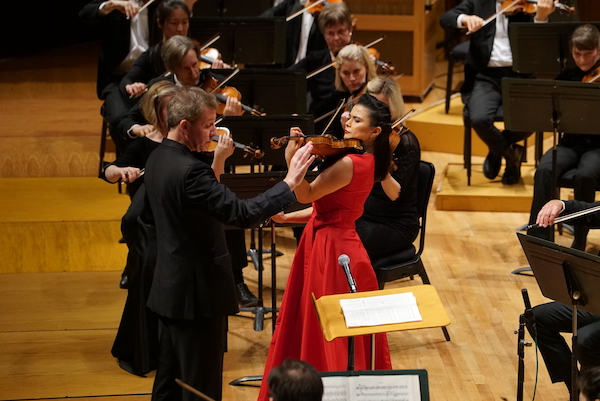Fischer, Gomyo team up for a stellar Tchaikovsky with Utah Symphony

Thierry Fischer and Karen Gomyo were great collaborators on Friday at Abravnel Hall, where a near-capacity crowd got to hear the conductor and guest soloist, respectively, play off one another as if by intuition and demonstrate their fine interpretive skills.
The occasion was Utah Symphony’s performance of Tchaikovsky’s Violin Concerto in a concert rounded out by contemporary composer Andrew Norman’s brief Spiral and Strauss’s mammoth Eine Alpensinfonie (An Alpine Symphony).
Fischer and Gomyo, leading the way, underscored the fluid melodicism of Tchaikovsky’s Allegro moderato first movement. With the tempo a bit on the slower side they were perhaps a bit too understated and relaxed. But there was good balance between soloist and orchestra, and Gomyo’s technical chops were evident in the nimble virtuosity she brought to the movement’s bravura passages and cadenza.
The slow, second-movement Canzonetta, a lovely lyrical outpouring for both soloist and orchestra, was given a finely shaded and delicate reading that brought out the music’s subtle dynamic inflections and delicate expressiveness. Gomyo’s musical side was showcased to the fullest here.
The finale, which bursts forth without pause, was a perky, vibrant affair with a lively tempo that made the well-executed playing by both the soloist and orchestra stand out. The delivery on Friday was crisp, well-defined and cleanly articulated.
Before welcoming the Tokyo-born, Berlin-based Gomyo to the stage, Fischer and the orchestra opened with Norman’s Spiral. The short piece is basically a very slow, deliberate crescendo, starting from absolute silence (a la John Cage) to the entire orchestra playing, although not full-on fortissimo. In between, the strings play a repeated phrase, over and through which various instruments individually punctuate the static sound. It’s an effective little piece obviously inspired by minimalism and pointillism.
The concert’s second half was handed over to Strauss and his massive, nearly hour-long homage to the outdoors — last heard in Abravanel Hall in 2012, also with Fischer at the podium. Unlike eight years ago, this performance of Eine Alpensinfonie had the titles of the work’s sections projected on a narrow screen above and behind the orchestra.
Atypical for Strauss, the work had a long and convoluted genesis. Strauss had toyed with the idea of writing a piece about the Alps around 1899, and after many discarded attempts and ideas he finally developed the work into its present form, which he premiered in 1915.
More than almost any other composer, Strauss had an uncanny knack to write descriptive music couched in brilliant orchestration, and in this work he does a magnificent job depicting a hiker (no doubt Strauss himself, who was an avid lover of nature) spending the day from sunup to sundown wandering in the Alps.
An Alpine Symphony is truly a tour de force for the orchestra, requiring dynamic yet refined playing from the musicians. And Fischer, with his fine command of the score, elicited a vibrant and effusive reading from his large forces. He conducted with broad strokes and bold gestures and captured the sweeping panorama that Strauss painted.
The orchestra responded with dramatic intensity and finely crafted dynamics in a performance that was robust and forceful, but never bombastic nor pompous. Fischer was careful to temper his account with a keen sense of balance and well-defined expressiveness.
The program will be repeated 5:30 p.m. Saturday at Abravanel Hall. utahsymphony.org; 801-355-2787.